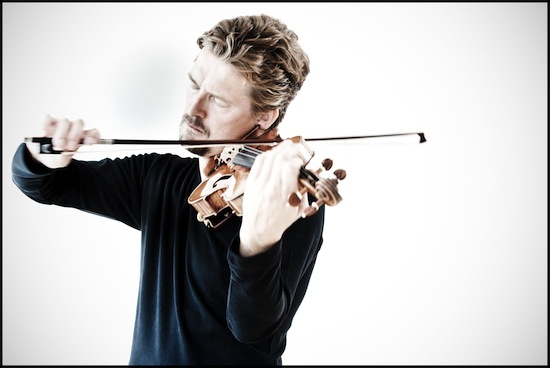Salonen, MET Orchestra, and Tetzlaff close Carnegie season in grand style

Christian Tetzlaff performed the Sibelius Violin Concerto with Esa-Pekka Salonen and the MET Orchestra Tuesday night at Carnegie Hall. Photo: Giorgia Bertazzi
You know it’s an unusual evening with the MET Orchestra when the work most familiar to the audience is the Sibelius Violin Concerto.
That work was part of the final concert of the ensemble’s series this week at Carnegie Hall. And soloist Christian Tetzlaff, in a spellbinding reading with conductor Esa-Pekka Salonen, showed a different interpretive side than he has in previous, more introspective appearances.
In the first movement, Tetzlaff was immediately captivating in tone and presence, digging in gruffly with the pacing of an athlete. His body language was telling: starting with his feet, the music often felt as if it were making a vertical arc through his body, ending with his bow hoisted vertically toward the sky. Heroism bested note-perfection; the violinist received applause at the end of the movement, even though some of the concerto’s tricky maneuvers left a few wrong notes in their wake. (He retuned briefly, before the second movement.)
The orchestra’s winds opened the Adagio with a flirtatious lilt, and Tetzlaff crept in surreptitiously, easing into the swirling sonorities (this time, his intonation was pure). The finale showed him at his best, with Salonen taking a brisk tempo. Rough, gutsy strokes alternated with supernaturally light ones. A sequence of perfectly judged harmonics sounded as if the violinist were whistling.
With many in the audience standing, an encore was inevitable, and Tetzlaff came up with a novelty: the Presto finale of Bartók’s Sonata for Solo Violin (1944). Its four or five minutes offer an expert musician the chance to surmount multiple obstacles, and in Tetzlaff’s hands, it was poetry.
The concert opened with a rare performance of Mahler’s Blumine (1884), originally conceived as the second movement of his First Symphony, but removed in the composer’s 1896 revision. It was rediscovered 70 years later, in 1966, and really should find its way into the concert hall more often. It made a rapturous ten minutes, especially with the orchestra’s principal trumpet, David Krauss, leading the way.
More Mahler came after intermission, with mezzo-soprano Anne Sofie von Otter in Kindertotenlieder, five piercing songs with texts by Friedrich Rückert that speak of parents’ longing for their departed children. Over the years, von Otter has appeared worldwide, at the Metropolitan Opera and elsewhere, but her gifts lie in the intimacy of song—ideally with “only” a pianist as colleague. Her gorgeous instrument, always on the soft side, has grown slightly more subdued in recent years, which made it sometimes difficult to hear her over Mahler’s immense orchestration.
That said, she chose wisely. Shepherding her resources, she showed expressive acuity, hitting her stride in the finale, “In diesem Wetter, in diesem Braus” (“In this weather, in this bluster”), in which the restless orchestral accompaniment gives way to a chamber music delicacy at the coda. In the final quiet moments, the singer was at her most poignant and alluring.
But the night’s treasure came at the end. For all of James Levine’s many glories, certain composers have remained off his radar: Bruckner and Shostakovich come to mind—and Sibelius. So it was a bold move for Salonen to end his three-concert stand with one of the composer’s masterpieces, the Seventh Symphony.
Written in 1924, the Seventh feels like a long, primal exhalation. In a single, 20-minute movement, it opens with gentle rustling that at first seems leisurely, but then evolves into brief, thunderous episodes, like random gusts of wind. Sibelius shows his love of nature in sequences that can seem pleasantly meandering. Only when the final, stirring pages fall into place does one realize how shrewdly the composer has organized his material.
Given Salonen’s patience and the orchestra’s expertise, the result was glorious. From the opening, an imposing, ascending scale in the strings, to some mellow wind choirs, all soared over Duncan Patton’s timpani heartbeat. And near the end, the trombones, led by Demian Austin and Weston Sprott, reached their climactic sunrise with an impeccable glow.
Posted Jun 07, 2017 at 7:58 pm by Susan Scheid
Brilliant review. Captures the experience of this concert exactly, most of all as to the genius of Sibelius’s 7th, magnificently performed.